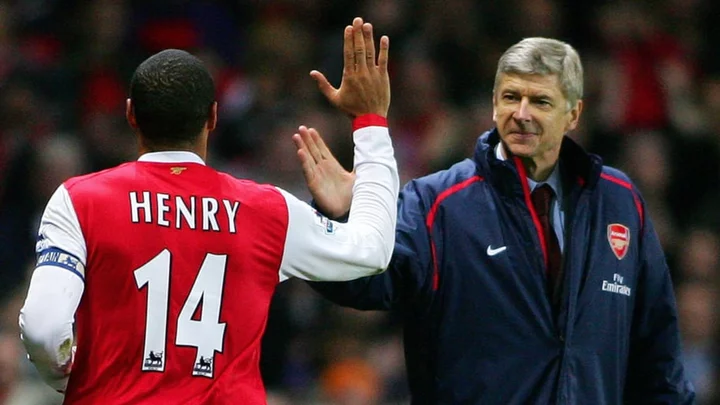Almost a century after he first took over the club, Arsenal are still framed in the image of the inimitable Herbert Chapman.
The visionary tactician revolutionised every aspect of Arsenal football club. Alongside the implementation of the W-M formation, Chapman introduced white sleeves to Arsenal's red kit and was a strong advocate of distinct digits on the back of shirts.
More than 10 years before the stuffy powers that be at the Football Association sanctioned squad numbers, Arsenal lined up from one to 11 against Sheffield Wednesday in 1928.
Across the subsequent decades, some digits have become embedded into the fabric of the club's history, indelibly linked with the most iconic individuals to have ever worn the red and white of Arsenal.
Arsenal's number 14
Prior to Thierry Henry's arrival - Arsenal's last signing of the 1990s - the number 14 was most closely linked with Martin Keown and aptly summed up his role as the understudy to the club's famed back four. Incidentally, it was the presence of another substitute which foisted 14 upon Henry.
Reuniting with his former Monaco manager Arsene Wenger, Henry had initially wanted the number 12 he wore in the Principality only to find it was worn by backup striker Christopher Wreh. A record-breaking 228 Arsenal goals later, Henry had made 14 arguably the most iconic number in the club's history.
Both Theo Walcott and Pierre-Emerick Aubameyang were reticent to fill the bulging sleeves of Henry's 14, only donning the famous digits once their first-choice preferences had been taken. Neither could match the output of the shirt's first reluctant owner.
Arsenal's number 11
As a striker prepared to drop deep and link with his midfielders, Robin van Persie preferred to call himself: "a nine and a half". However, he wore the number 11 at Arsenal during his first six seasons at the club.
Van Persie was following in the footsteps of two of Arsenal's most subtly decisive players of the modern era. Four years apart, Arsenal headed to Old Trafford in a direct title race with Manchester United. In both 1998 and 2002, the team's number 11 scored the only goal of the game to effectively win the title as Marc Overmars laid the path which his fleet-footed successor Sylvain Wiltord skipped along.
Charlie George wore a raft of numbers during his time at Highbury but was decked out in 11 for the greatest moment of his career. However, it is impossible to tell what is on his back from the defining image of the 1971 FA Cup final, as George celebrated his winning goal against Liverpool by lying spread-eagle out of sheer exhaustion.
Arsenal's number ten
Paul Merson was lauded as a "Rolls Royce" by his infamously stern manager George Graham (who also wore the number ten shirt during his days as a far more free-spirited player). Yet, Merson himself is quick to hail the man that took Arsenal's ten off him as "the greatest player ever".
The Dutch press had to invent a new term for the role which Dennis Bergkamp played at Ajax just behind the centre-forward, dubbing the technically masterful number ten a "schaduwspits"; a shadow striker.
At Arsenal, Bergkamp's appreciation of space between the lines was similarly revolutionary. Arguably none of Bergkamp's successors in the number ten shirt at Arsenal have been able to step out of his shadow, with Robin van Persie perhaps coming closest after he switched from 11 during his final two seasons at the club.
Centre-back William Gallas' possession of the shirt was certainly memorable - if not always for the right reasons.
Arsenal's number seven
Arsenal's seven has perhaps been draped across the back of more quality players than any other number on the roster; from the shirt's very first owner, Joe Hulme - who remains one of the top ten goalscorers in the club's history - to its current inhabitant Bukayo Saka.
The number has inspired many different styles of players. Robert Pires represented the prolific wide man, George Armstrong never shirked his defensive duties while David Rocastle could do it all; the seven has been home to goal scorers, grafters and all the geniuses in between.
Arsenal's number four
Across his near decade in Arsenal's colours - which he tried to change to all red in the mid-60s - before the age of settled squad numbers, Frank McLintock was no stranger to wearing five or six. However, the commanding Scottish centre-back, captain of the double-winning side in 1971, wore number four more often than anything else, setting a precedent of team leaders in the famous digit.
Arsenal have spent the best part of two decades looking for Patrick Vieira's replacement as an all-action midfielder and are yet to come up with an alternative that comes close to the Invincibles skipper.
Cesc Fabregas wore number four in honour of his Barcelona idol Pep Guardiola and became the second-youngest captain in Arsenal's history after two years in the shirt. Per Mertesacker inherited the four from Fabregas and - eventually - the armband.
On this week's edition of The Chronicles of a Gooner, part of the 90min podcast network, Harry Symeou discusses Arsenal's first friendly of the summer against Watford. We discuss when we can expect announcements for Declan Rice and Jurrien Timber, Kai Havertz making himself at home and take some of your questions from the live chat!
If you can't see this embed, click here to listen to the podcast!
This article was originally published on 90min as Arsenal's most iconic shirt numbers.

